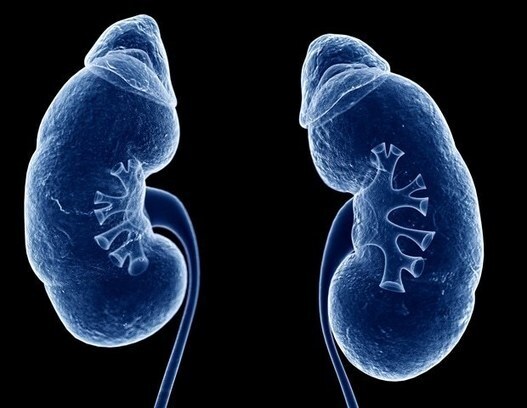
New microfluidic device brings affordable kidney testing to the point of care
www.news-medical.net
June 3, 2025, 8:23 a.m.
Chronic kidney disease (CKD) affects over 800 million people globally and is often diagnosed too late for effective intervention. Early detection depends on accurate measurement of biomarkers such as creatinine and the urine albumin-to-creatinine ratio (uACR). While urine testing is non-invasive and informative, standard methods are time-consuming, costly, and require specialized facilities. Existing point-of-care devices offer convenience but remain prohibitively expensive or technically complex for many users. As such, there is an urgent need for a robust, affordable, and easy-to-use platform to measure urinary creatinine with clinical precision.
Share on
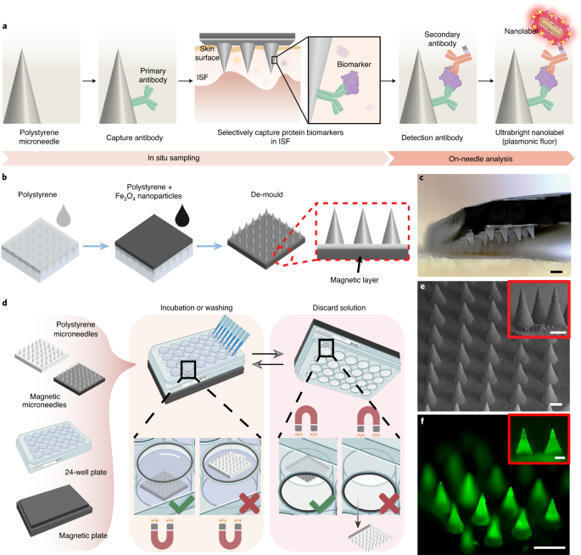
Microneedle patch for the ultrasensitive quantification of protein biomarkers in interstitial fluid
www.nature.com
March 12, 2025, 5:51 p.m.
The detection and quantification of protein biomarkers in interstitial fluid is hampered by challenges in its sampling and analysis. Here we report the use of a microneedle patch for fast in vivo sampling and on-needle quantification of target protein biomarkers in interstitial fluid. We used plasmonic fluor—an ultrabright fluorescent label—to improve the limit of detection of various interstitial fluid protein biomarkers by nearly 800-fold compared with conventional fluorophores, and a magnetic backing layer to implement conventional immunoassay procedures on the patch and thus improve measurement consistency.
Share on

DNA testmaker BillionToOne claims billion-dollar valuation with $130M funding round
www.fiercebiotech.com
March 4, 2025, 3:12 p.m.
BillionToOne said that since launching its first tests in 2020, over 500,000 patients have been evaluated to date, driving $125 million in annual revenue.
Share on

FDA, Gates Foundation team up on breath-based diagnostic tests
www.fiercebiotech.com
March 4, 2025, 3:08 p.m.
The FDA has launched a project with the Bill and Melinda Gates Foundation to help aid the development of breath-based diagnostics for detecting diseases more easily among underserved populations. The TB-focused project with the FDA follows up on the Gates Foundation's interest in breath biopsy tests developed by Owlstone Medical.
Share on

Flavored lollipops may offer non-invasive mouth cancer detection
interestingengineering.com
March 25, 2024, 11:59 a.m.
Diagnosing mouth cancer often involves invasive and uncomfortable procedures like biopsies and nasoendoscopy (inserting a flexible tube with a camera into the nose or mouth). However, scientists at the University of Birmingham are paving the way for a more patient-friendly approach – flavored lollipops that could potentially detect mouth cancer. This innovative research has garnered significant support, with Cancer Research UK and the Engineering and Physical Sciences Research Council providing £350,000 in funding.
Share on
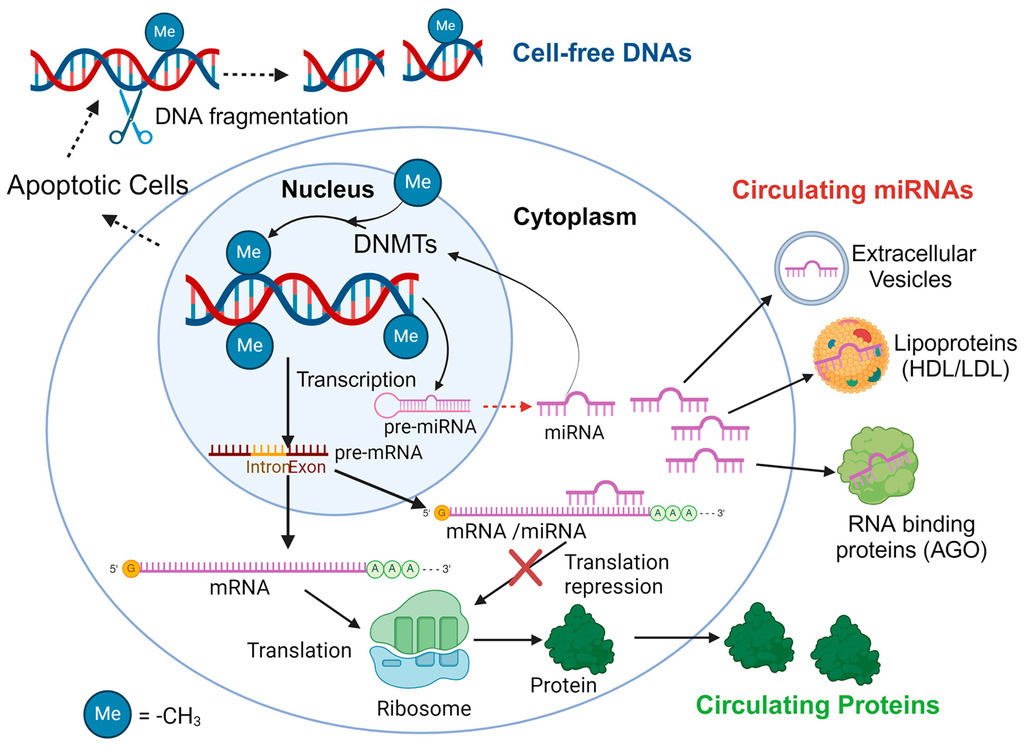
The Circulating Biomarkers League: Combining miRNAs with Cell-Free DNAs and Proteins
www.mdpi.com
March 18, 2024, 8:18 a.m.
The potential of liquid biopsy for the prognosis and diagnosis of diseases is unquestionable. Within the evolving landscape of disease diagnostics and personalized medicine, circulating microRNAs (c-miRNAs) stand out among the biomarkers found in blood circulation and other biological fluids due to their stability, specificity, and non-invasive detection in biofluids. However, the complexity of human diseases and the limitations inherent in single-marker diagnostics highlight the need for a more integrative approach. It has been recently suggested that a multi-analyte approach offers advantages over the single-analyte approach in the prognosis and diagnosis of diseases. In this review, we explore the potential of combining three well-studied classes of biomarkers found in blood circulation and other biofluids—miRNAs, DNAs, and proteins—to enhance the accuracy and efficacy of disease detection and monitoring. Initially, we provide an overview of each biomarker class and discuss their main advantages and disadvantages highlighting the superiority of c-miRNAs over the other classes of biomarkers.
Share on

23andMe’s Fall From $6 Billion to Nearly $0
www.wsj.com
Feb. 3, 2024, 5:57 p.m.
Five years ago, 23andMe was one of the hottest startups in the world. Millions of people were spitting into its test tubes to learn about their ancestry. Oprah had named its kit one of her favorite things; Lizzo dressed up as one for Halloween; Eddie Murphy name-checked the company on “Saturday Night Live.” 23andMe went public in 2021 and its valuation briefly topped $6 billion. Forbes anointed Anne Wojcicki, 23andMe’s chief executive and a Silicon Valley celebrity, as the “newest self-made billionaire.” Now Wojcicki’s self-made billions have vanished. 23andMe’s valuation has crashed 98% from its peak and Nasdaq has threatened to delist its sub-$1 stock. Wojcicki reduced staff by a quarter last year through three rounds of layoffs and a subsidiary sale. The company has never made a profit and is burning cash so quickly it could run out by 2025.
Share on

New Eye Clock Predicts Aging Through Fluid Proteins
neurosciencenews.com
Oct. 25, 2023, 12:47 a.m.
Researchers have pioneered a method to measure ocular aging by studying proteins in eye fluid. Using artificial intelligence, they crafted an “eye-aging clock” from 26 out of nearly 6,000 proteins which can forecast aging. Their findings can lead to more personalized medical treatments and help in understanding disease triggers. The team aims to employ this method to other body fluids, enhancing drug development for various ailments.
Share on
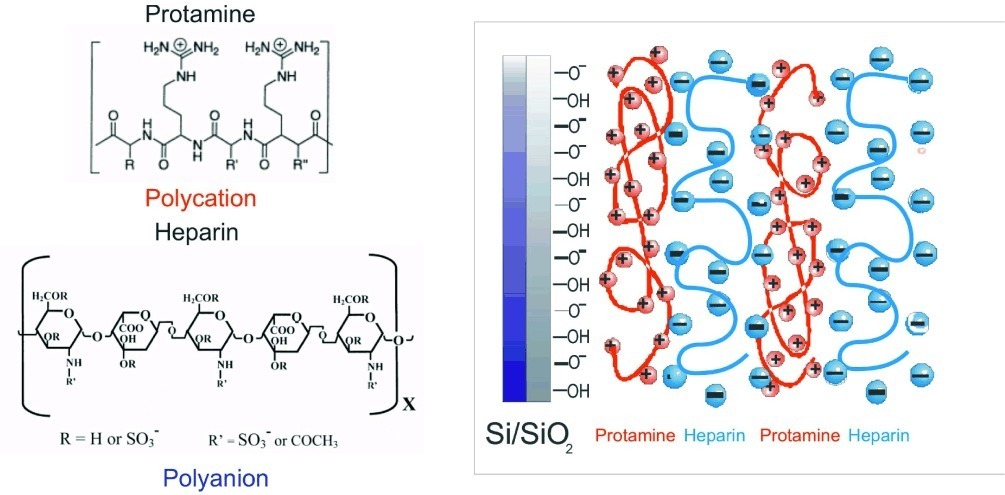
Title Monitoring Protamine‐Heparin Interactions Using Microcapillary Impedimetric Sensor
analyticalsciencejournals.onlinelibrary.wiley.com
Aug. 20, 2023, 12:03 p.m.
We report an impedimetric sensor based on an interdigitated electrode array with electrode digits located at the bottom of microcapillaries formed in silicon dioxide which is used to monitor protamine-heparin interactions. Modification of the active sensor surface with protamine, a cationic protein used as a high affinity heparin antagonist, permits to register protamine-heparin complex formation as changes in the surface conductivity determined from the sensor impedance measured in an electrolyte solution.
Share on

The DermaSensor device promises to aid providers in the detection of skin cancer
faimglobal.org
Aug. 12, 2023, 3:34 p.m.
Skin cancer is a prevalent cancer in the US. Detecting it is a pressing need. The FDA granted breakthrough device designation to The DermaSensor, a device that helps identify suspicious lesions for skin cancer. The DermaSensor is a non-invasive device that works by spectrometry. This device captures the substructure image of the cells and, together with software powered by machine learning, yields in just seconds an analysis of the nature and characteristics of the lesion.
Share on

Ultraflexible tattoo electrodes for epidermal and in vivo electrophysiological recording
www.cell.com
March 21, 2023, 5:55 a.m.
Tattoo electronics, flexible patches that mount directly onto the skin with the ease and flexibility of a temporary tattoo, have foreseen remarkable application potentials in personalized healthcare monitoring and human-machine interfaces. Documented tattoo electronics mostly have an on-skin form factor to date. Using dermal tattoos for in vivo diagnostics presents an unexplored paradigm. Here, we extend the application scenario of “tattoo electrodes” from an on-skin fashion to an actual under-skin configuration, enabled by a highly soft, conductive, and biocompatible polymer matrix.
Share on

Wrist-worn device can accurately predict troponin-I and obstructed arteries in five minutes
www.news-medical.net
March 13, 2023, 1:57 a.m.
The results indicate that the system predicts troponin-I levels with about 90% accuracy. In addition, the findings correlated well with clinical evidence of a heart attack; people with abnormal troponin levels as measured by the device were about four times as likely to have an obstructed artery compared to people with a negative troponin result as measured by the device. Download source article at: https://www.researchgate.net/publication/369076645_A_Novel_Breakthrough_in_Wrist-Worn_Transdermal_Troponin-I-Sensor_Assessment_for_Acute_Myocardial_Infarction/fulltext/64088c2f0d98a97717ec869f/A-Novel-Breakthrough-in-Wrist-Worn-Transdermal-Troponin-I-Sensor-Assessment-for-Acute-Myocardial-Infarction.pdf
Share on
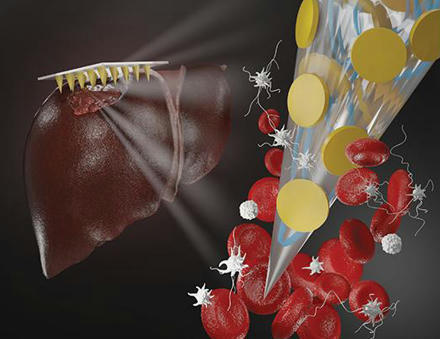
Microneedle Bandage for Hemostatic Control
www.medgadget.com
Feb. 6, 2023, 3:24 p.m.
Scientists at Penn State have developed a microneedle bandage that can rapidly stop bleeding. Uncontrolled bleeding following a traumatic injury is a major cause of death in the young, and developing new medical technologies that can rapidly stop bleeding would be highly beneficial. This bandage contains an array of biodegradable and biocompatible microneedles made using a gelatin methacryloyl biomaterial. The device also contains silicate nanoplatelets that give it its hemostatic properties, and the needle structure increases the surface area for blood contact and helps to bind the bandage to the injured tissue.
Share on

Pop-Up Electrode for Improved Neural Interfaces
www.medgadget.com
Feb. 6, 2023, 3:23 p.m.
Researchers at Penn State designed a pop-up electrode for brain monitoring and other applications requiring neural interfacing. The pop-up design starts life as a folded two-dimensional structure with a rigid outer coating that makes it easy to insert into the brain. Once in place, the hard coating dissolves, revealing a softer and more flexible material that is less likely to cause tissue damage. The device can unfold, like the structures in children’s pop-up books, to form a surface electrode array and four penetrating shanks that can measure signals from deeper within the neural tissue. The researchers hope that the device will help to drive advanced medical technologies, such as brain computer interfaces.
Share on
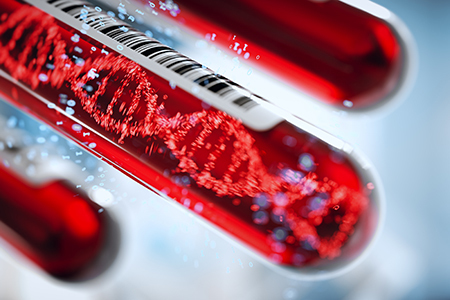
Liquid Biopsy – What’s real and what’s hype?
advisory.kpmg.us
Feb. 3, 2023, 3:38 p.m.
While it holds much future promise, the path to unlocking the full market potential of liquid biopsy is not necessarily clear to stakeholders such as pharma and biotech, diagnostics companies, and healthcare providers. We believe that: Pharma and biotech must invest in use beyond treatment selection Diagnostics manufacturers and labs must continue to focus on test quality and clinical utility Healthcare providers must take a more active role in driving adoption
Share on

L'hôpital Foch collabore avec la start-up Surge pour prédire les complications post-chirurgicales
www.usine-digitale.fr
Jan. 24, 2023, 4:56 p.m.
La start-up Surge a choisi l'hôpital Foch pour tester son algorithme de prédiction des complications post-opératoires à partir d'un échantillon de sang. Un premier essai clinique, mené aux Etats-Unis, a montré des résultats intéressants.
Share on
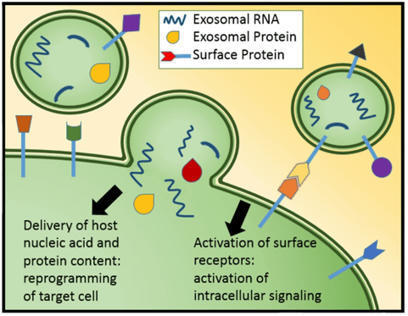
Exosomal Surface Markers-based Exosome Characterization
www.creative-biolabs.com
Jan. 23, 2023, 9:51 p.m.
Exosomes derived from cells under both normal and pathological conditions. Exosomes contain diverse types of proteins including common membrane and cytosolic proteins as well as origin-specific subsets of proteins reflective of cell functions and conditions. Empowered by leading technologies as well as years of experience in this field, Creative Biolabs has successfully launched an innovative exosome characterization platform for investigating the release of exosomes and exosomal markers value.
Share on
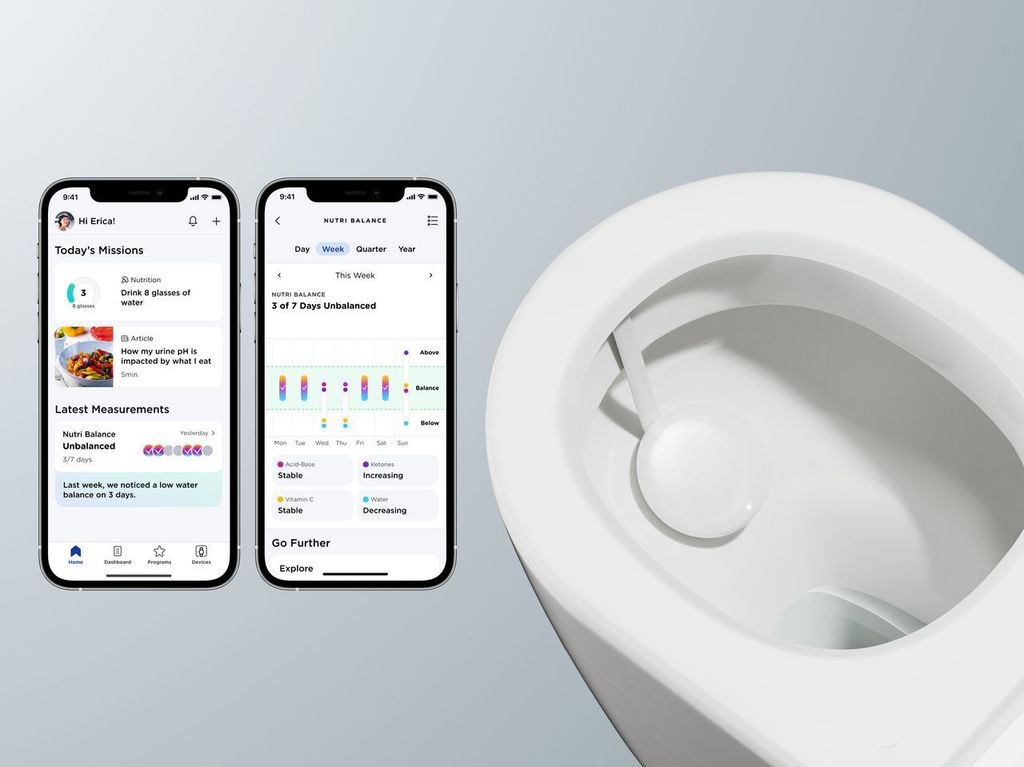
Withings U-Scan: le 1er laboratoire personnel d'analyse d'urine connecté triplement récompensé au #CES2023 !
www.maison-et-domotique.com
Jan. 10, 2023, 5:51 p.m.
Véritable révolution dans le suivi de santé quotidien, Withings U-Scan est conçu comme une plate-forme modulaire composée d'un lecteur en forme de galet avec des cartouches d'analyse interchangeables qui évaluent des biomarqueurs spécifiques sans qu'il soit nécessaire de faire des prélèvements d’échantillons ou de manipuler des bandelettes urinaires. Grâce à une synchronisation automatique avec l'application Health Mate, il fournit une multitude d'informations exploitables basées sur une mesure quotidienne.
Share on

Wearable skin patch could help clinicians diagnose tumors, organ malfunction and more
www.news-medical.net
Dec. 26, 2022, 10:35 a.m.
The photoacoustic patch comprises several different ultrasonic transducers that detect acoustic waves and vertical-cavity surface-emitting laser (VCSEL) diodes. Both types are integrated on a common substrate composed of an elastomeric matrix and are linked to each other by coiled metal electrodes.
Share on

First-Ever Blood Test Could Detect Deadly Heart Inflammation Within Hours
www.labmedica.com
Nov. 28, 2022, 11:22 p.m.
Myocarditis, or inflammation of the heart muscle, is a difficult condition to diagnose. Now, the discovery of a molecular signal in the blood could pave the way for the first blood test to be used for diagnosing myocarditis within as little as a year.
Share on